-
Fear and Loathing in Katmai
What makes a simple walk in Katmai National Park terrifying? Bears, lots of bears.
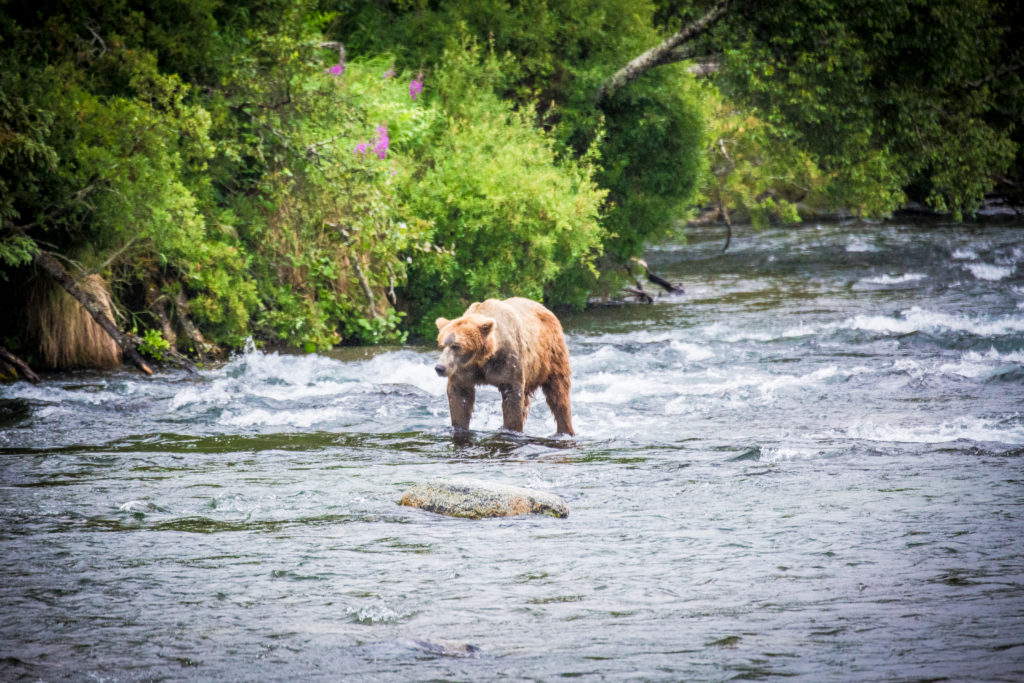
Fear and Loathing in Katmai
JULY 2017:
Standing on the docks in the remote Alaskan village of King Salmon, I was suddenly reminded of my distaste for flying in small planes. That, and my fear of bears. Yet here I was, about to board a single-engine floatplane and fly to Brooks Camp in Katmai National Park, a location claiming one of the “densest seasonal concentrations of bears on earth.” A place without vehicles or road access but instead afflicted, I would learn, with the all-too-common traffic problem known as a “bear jam.”
As the pilot taxied the de Havilland Otter floatplane out into the waterway, I looked over at John and quietly began blaming him for everything. Threatening-looking rain clouds. The oversized lawnmower we were to take flight in. The lack of Wi-Fi. I’d known John for more than a decade in Anchorage but until then had only been on the listening end of his adventures—a fishing excursion to remote China, a road trip through Patagonia, too many Alaska stories to count. John was in his early 50’s, with thin brown hair and a slim frame that hunched forward at the shoulders. He spoke in a quiet gravelly voice and seemed most at ease in his decade-old flannel button downs. John had invited me to join him and his sister Sue, who would be visiting from New Jersey, on a three-day trip to Brooks Camp. This being the place, he said, where coastal brown bears often outnumber people and, most notably, could be seen up close snatching salmon out of thin air from atop a waterfall. It sounded to me like a terribly illogical arrangement, a place without fences and the sole purpose of getting a person within sniffing distance of a twelve-hundred-pound wild bear. John had been there at least seven times and concluded that it was “pretty special.”
As is my nature, I scrambled for a good excuse. A dentist appointment, the cat’s annual vet checkup, a can’t-miss episode of Dateline on television. Is anyone in my family sick or close to dying, I wondered. But my calendar, it seemed, was painfully empty and everyone appeared in good health.
“You should do it Brad—think how much fun it will be!” Victoria said. After nearly ten years of marriage, she knew I was prone to dithering and sometimes needed a bit of encouragement.
“And what great photos you’ll get!”
“You could go,” I said.
“Nope,” she shot back. “With all those bears out there? Are you crazy?”
John assured me that with Sue being a novice in the ways of Alaska this trip would be tame, the wilderness-equivalent of plain vanilla. “We’ll be fine,” he said with a low chuckle, “as long as we don’t get eaten.”
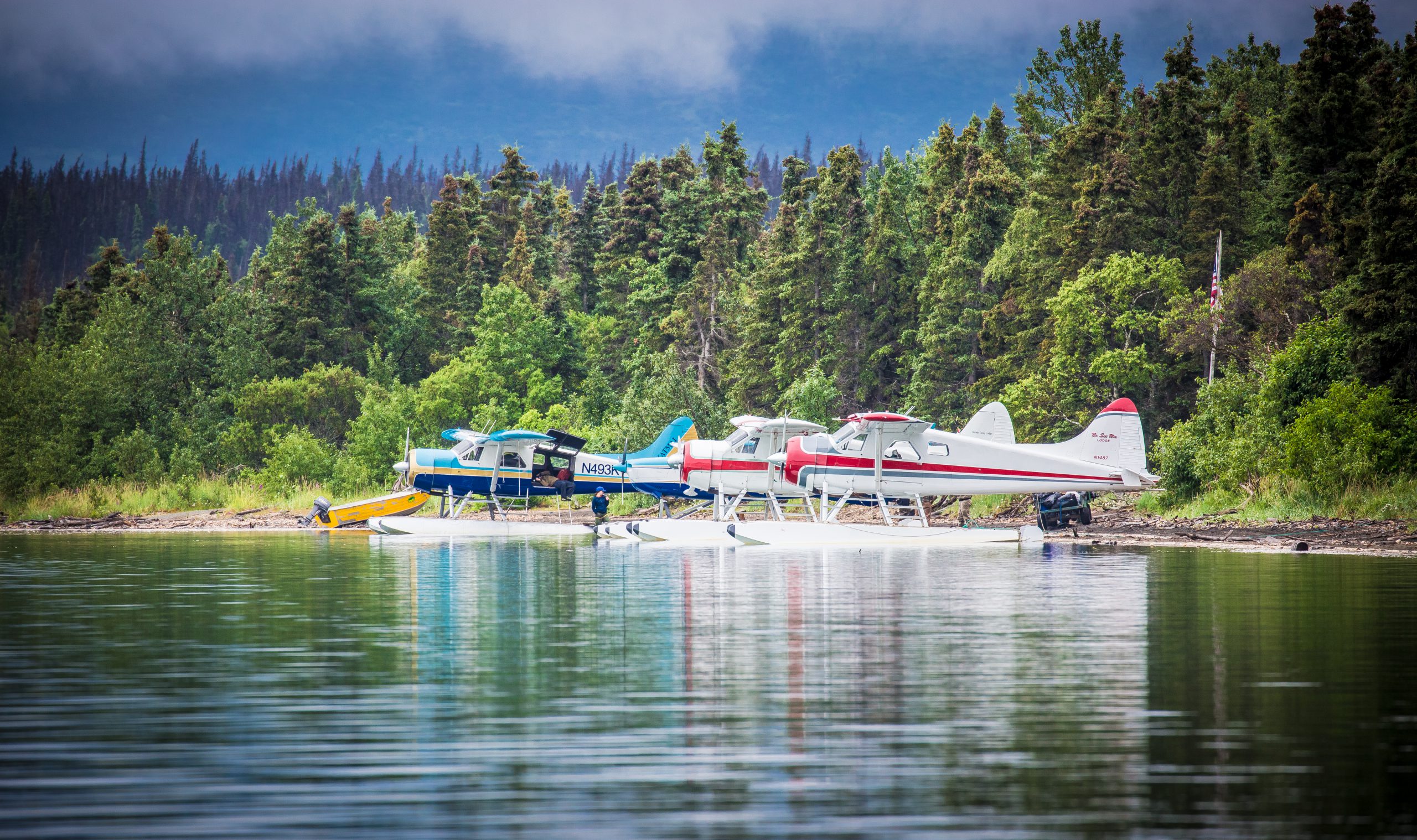
As we bumped across the surface of the water and took flight above King Salmon, I realized that after nearly two decades in Alaska it was my first time in a floatplane. Brooks Camp would also be the most remote Alaskan place I’d ever been to, far away from any city grid, roadway or working cell phone. Years earlier, at the age of twenty-two I moved from Kentucky to Alaska with the same forethought one might deploy for a sneeze. To a young idealist the Last Frontier presents itself as an irresistibly grand adventure. Alaska also happened to be the most exotic place I could afford. Life, as it tends to do, took root. But over time my definition of adventure faded into something more listless—the adrenaline burst of a trek into the mountains was replaced with the drama of an unplanned trip to the linen section of Target or the discovery of a hairball on the carpet.
Seated in front of me on the floatplane was John’s older sister Sue, a school administrator from New Jersey. It was her first time aboard a floatplane too, and she marked the occasion with a smart turtleneck sweater and jeans. I gathered that after hearing about her brother’s many travels in Alaska she’d finally been convinced to join him on a trip.
“I updated my will before leaving for Alaska,” Sue told me. “I don’t know what John’s getting us into here.”
From the air the turquoise waters of Naknek lake mirrored the cumulus clouds above, creating a dizzying infinity of liquid glass. After 30-minutes our pilot cushioned us down and parked snugly in a row of floatplanes lining the beach. We stepped from the floats of the airplane and crunched into beige-colored pumice rocks, evidence of a century-old eruption at the nearby volcano Novarupta and proof that we had entered a different world.
Time in Katmai National Park, it appears, is measured primarily in eons and ages. This four-million acre mass of earth adjacent to Kodiak Island in southwestern Alaska is as untouched as a wilderness area in the modern world can hope to be. Fifteen active volcanoes along the Shelikof Strait stretch their tendons down into a molten cauldron seething beneath the substrate of the Pacific Ring of Fire. At least ten times in the last 7,000-years significant eruptions have coated areas of Katmai in a blanket of volcanic ash. It is a foreign world, here on earth, that few will ever know.
Human access to the parkland is by water or air alone, and even then traveling into its wildest depths requires a level of planning akin to space exploration. The only terrestrial mode of transportation is a 23-mile dirt road connecting Brooks Camp with the Valley of Ten Thousand Smokes, a 40-square mile swath of land that was once buried in some 700-feet of volcanic ash and pumice when Novarupta unleashed its violence in 1912. This was no minor puff of volcanic gas, but rather the most powerful recorded eruption of the 1900’s. It blackened the skies for two days in Kodiak more than 100-miles away and when the darkness cleared, residents found a layer of ash so thick and heavy that it had collapsed the roofs of some buildings.
Yet to a Katmai National Park visitor this volcanic prehistory plays second fiddle to a more daunting reality. Katmai is today known almost exclusively as a wilderness crawling with the world’s largest protected concentration of brown bears, the ursus arctos—Alaska’s most feared predator, apart from the mosquito some might say.
After stepping onto the beach at Brooks Camp, our group was directed to a small cabin through a patch of trees. Inside, a perky young ranger launched into a well-rehearsed introduction before stopping mid-sentence as two older women stared in through a window. It was a look that suggested they were not so taken with the great outdoors. “I think they just like to watch the video,” the ranger mouthed to us with a puzzled look. “They’ll just sneak in and play it over and over again. Anyhow! Let’s get this party started!”
The ranger pressed play on a mandatory bear safety video, which featured 1980’s era people hiking, camping and fishing in bear country. It occurred to me that while our sense of style had improved vastly in recent decades, sadly, bear-fashion remained unchanged. (Well, there’s proof that we truly are superior, I thought.) The video rattled off the do’s and don’ts of bear safety—do make noise while hiking, don’t run from bears, do give bears the right-of-way on trails, don’t carry food, do travel in groups, don’t look a bear directly in the eyes. So jarring was the image of people—armed with only the enormity of their voices—sharing fenceless open spaces with giant lumbering brown bears that suddenly the thought of spending the day in the cabin seemed quite reasonable.
“We’ll let John go first just in case there are bears,” Sue said as we began the half-mile long hike down a narrow, wooded footpath toward the campground. “Me and Brad will be hiding behind you.” John lowered his head and charged off down the trail as we scampered to catch up.
At any moment I expected to hear a distant rumble in the forest, followed by a crashing of trees as a brown bear exploded onto the trail and tore through our group with a flurry of claws and teeth. Every snapping twig, trembling leaf, drop of rain and fluttering bird was captured by my senses, assessed for risks and then released back into the wild. It was terrifying and exciting—just enough danger to sharpen your vision.
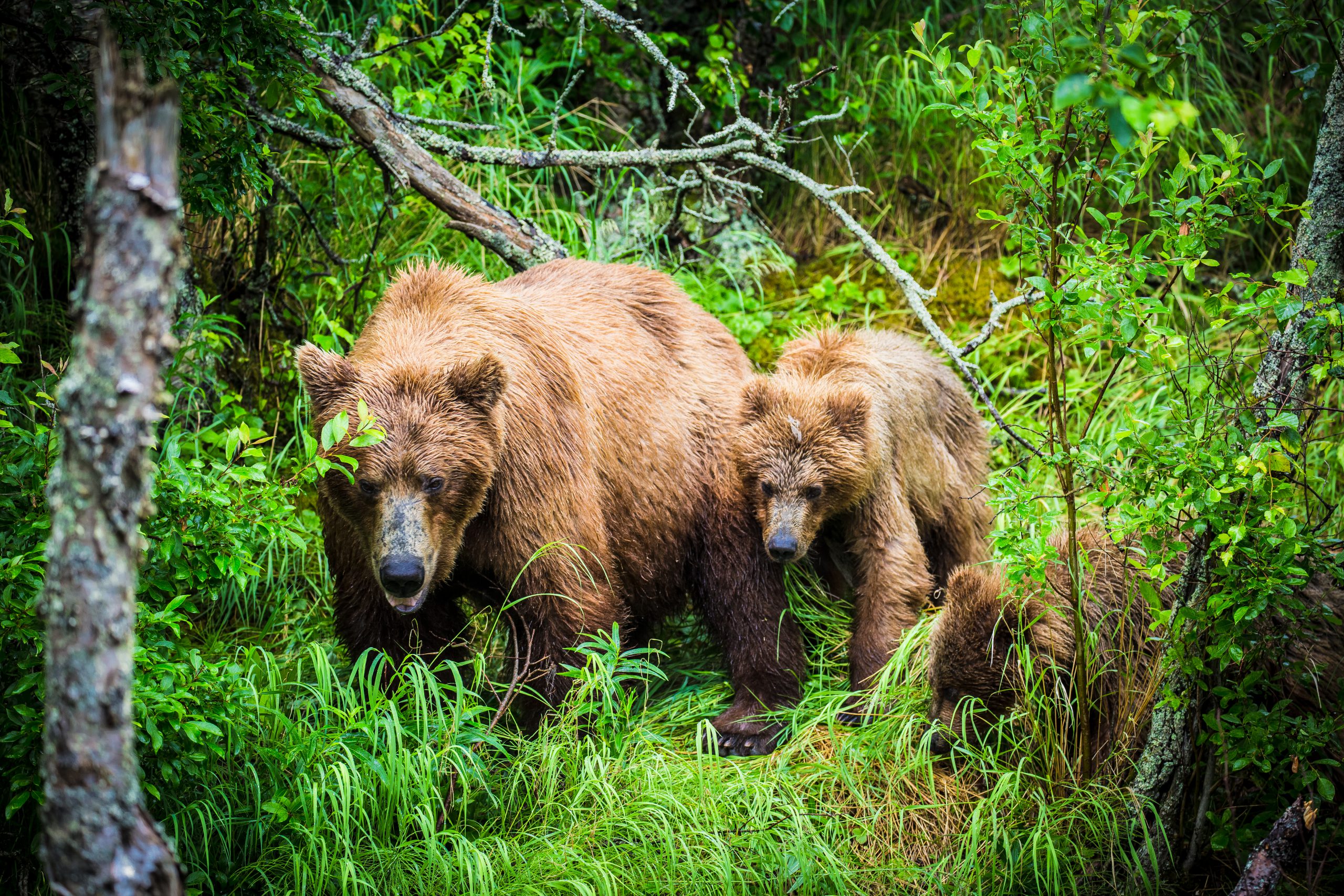
What makes a mere human tremble is the knowledge that bears are simply out there among the underbrush and babbling streams of Brooks Camp, unseen and unheard, ambling through the wilderness holding their menace quietly like a lantern in the dark.
A walk through bear country, it turns out, conjures a fear that logic alone cannot cure. Since Brooks Camp opened in the 1950’s brown bear populations have boomed, largely due to a ban on sport hunting. People too have increasingly migrated to this small wooded collection of buildings along Naknek Lake to fish nearby rivers and streams or to photograph bears standing atop Brooks Falls. Yet even with this swell of people and bears there is not a single fatal bear attack or mauling on record at Brooks Camp. The most recent close call came in 1983 when a nosy sow named Sister had to be killed by rangers after she got a taste of human food and became too curious about people.
But since then, nothing. Countless people and bears wandering through the fenceless wooded country surrounding Brooks River and not a single alarming incident worth noting.
In Katmai National Park at large, it turns out, there have been only two fatal bear attacks. Timothy Treadwell, a free-spirited bear-whisperer and self-proclaimed eco-warrior—the type of outsider Alaskans might eagerly dismiss—and his girlfriend Amie Huguenard were attacked and killed by a coastal brown bear near their tent in Kaflia Bay on the southwestern coast of Katmai in 2003. Treadwell had spent many summers in Katmai filming bears at distances that would send most people into cardiac arrest. An audio recording of the attack revealed the work of a single bear, first mauling Treadwell before turning to Huguenard. When rangers came upon the campsite they found Treadwell’s head and spine separated from his body. Nearby they located his arm, wristwatch still attached. Huguenard’s remains appeared to have been cached, buried in the dirt near the tent. The scene was pure animal brutality, yet it remains the only pall cast across decades of bear/human history in Katmai—an attack perpetrated on individuals actively attempting to coexist with the largest terrestrial predators on the planet.
By any measure, that is a remarkably low homicide rate.
Yet there on the trail, the odds seemed hollow. There should be some solace, I supposed, in the profound lack of bear/human encounters. But then again, perhaps it simply meant Katmai or Brooks Camp was due for an attack. It is this sort of morbid calculus that rattles around in your mind when taking a stroll through bear country.
If you were to meet a Katmai brown bear alone on a remote trail it would be impossible to ignore its nature. Standing before you would be a creature whose violent potential reads somewhat like a casting call for destructive power: An unpredictable 1000-pound animal that can run 30-miles per hour, has the bite strength to crush a human skull, claws precise enough to slice the marrow out of bone and the demeanor to train its ferocity swiftly upon a target. All of this, along with the capacity to stroll through the forest without so much as troubling the silence.
What makes a mere human tremble is the knowledge that bears are simply out there among the underbrush and babbling streams of Brooks Camp, unseen and unheard, ambling through the wilderness holding their menace quietly like a lantern in the dark.
With John still firmly in the lead, we reached the campground and saw three strands of cord strung limply like barbed wire around the perimeter, which we were told was an electric fence. “Brad, we can just stay inside the fence here. See you later John!” Sue laughed once we were inside the campground.
“I don’t think the fence was working the last time I was here,” John said. “They just tell the tourists it’s electric so they don’t get scared.” It struck me that if a bear wanted inside the fence, it needed only the ability to propel its mass forward, electricity or not, in a manner one might refer to as walking.
The best place to see bears, the reason we’d come here, was Brooks Falls, an eight-foot high waterfall near the halfway point of the Brooks River. Getting there required leaving the rickety electric fence at the campground and hiking approximately a mile and a half along a densely wooded trail. Rangers patrolled the trails by day and monitored bear activity to encourage a harmonious existence between people and bears. If a bear decided to nap in the middle of the trail or wander onto a narrow footbridge, rangers brought people to a halt. This was called a bear jam which, we were told, could last for hours and cause visitors to delay their return flights or, worse, miss dinner service in the small café at Brooks Lodge.
“We’ll hike out to the falls this evening,” John explained as I fumbled to setup the fraying turquoise tent that accompanied me during my first summer in Alaska. “The rangers are off duty and there will be less people.” By the time we were settled at our campsite, it was late in the afternoon and the sun hid behind thick gray clouds. With nearly 22-hours of summer daylight, darkness was not a viable reason to stay behind the electric fence.
“But if the rangers are off, who’s watching for the bears?” Sue asked.
“Nobody,” John said with a devious smile. “The bears are watching for us.”
 The Brooks River is a meandering 1.5-mile cut-bank waterway, a minor sinew draining from Lake Brooks to the south and flowing into the much larger Naknek Lake, which finds its headwaters nearly fifty miles to the west in Alaska’s famed Bristol Bay. It is this path that millions of spawning salmon reverse each summer, swimming against the current, returning from the ocean to procreate and then complete nature’s most noble death in the precise places in which they were born. By July the salmon are flooding mercilessly from the ocean into the Naknek River, hugging the shores of Naknek Lake in waves, cramming into the narrowing mouth of the Brooks River and congregating finally, inevitably at Brooks Falls where they huddle impatiently like New Yorkers log jammed at the base of a subway staircase.
The Brooks River is a meandering 1.5-mile cut-bank waterway, a minor sinew draining from Lake Brooks to the south and flowing into the much larger Naknek Lake, which finds its headwaters nearly fifty miles to the west in Alaska’s famed Bristol Bay. It is this path that millions of spawning salmon reverse each summer, swimming against the current, returning from the ocean to procreate and then complete nature’s most noble death in the precise places in which they were born. By July the salmon are flooding mercilessly from the ocean into the Naknek River, hugging the shores of Naknek Lake in waves, cramming into the narrowing mouth of the Brooks River and congregating finally, inevitably at Brooks Falls where they huddle impatiently like New Yorkers log jammed at the base of a subway staircase.
It is here, slowed by the height of the falls, that the salmon arrive to toil anxiously with dozens of hungry brown bears.
Overlooking this life-and-death struggle at Brooks Falls is an elevated wooden platform allowing visitors to observe bears as if in a zoo. The National Park Service constructed a network of platforms and decking near the popular Brooks Falls in the early 1980’s as visitor traffic began to surge. It was built to strategically control the flow of people in the natural world, yet it also serves as a microcosm of the development vs. nature conflict that in many ways has come to define Alaska in the modern age. Even as we trekked through Brooks Camp a debate was raging over the National Park Service’s plans to replace a 300-foot floating bridge across a lower section of Brooks River. The floating bridge had become a hot spot for lengthy and inconvenient bear jams. The proposed new raised structure would put two permanent 800-square-foot platforms on either side of the river and allow people to move more seamlessly to and from Brooks Falls. Opponents argued that the structure was an impediment to the natural habitat of the bears, just another example of the forces of money and politics chipping away at the real Alaska, they claimed. It’s a conflict that symbolizes just what a grand riddle Alaska has presented to humanity. Ever since explorers, pioneers and native peoples began etching footprints into Alaska’s unfathomable sprawl, pushing out into its storm-ravaged shores, its bear-infested woods, its roadless untouched frontiers, its forbidding arctic territories or its punishing high mountains, there has been but one simple question: How do we solve this place?
As I stood inside the campground staring at three flimsy electrified wires, it struck me that the answer is almost always inadequate.
We left the security of the campground and John again lowered his head and charged down the narrow trail ahead of us, his hands slapping the air with each step. With every blind twist I cringed, certain that we would be eye-to-eye with a towering brown bear at any moment. John never broke stride, strolling casually around trees, breezing past steaming piles of bear excrement and giant impressions in the brush where massive animals had clearly paused to sleep. Along the way, John pointed out a spot where on a previous trip he had to quickly jump off the trail to avoid two adolescent bears running towards him, evidently chasing one another. “That was pretty fun,” he said.
“Well, let’s hope that doesn’t happen to us, right Brad,” Sue said. While every logical bone in my body wanted to agree, my feeling was that I could only go so far with Sue on this shared sense of fear. Something in her tone made me feel like a fraud. Here I had been living in Alaska for nearly two decades and she was an east coast city-dweller, a visitor, an outsider. How could she see me as an ally?
“Right, yeah. Let’s hope that doesn’t happen,” I mumbled as we continued behind John.
But in reality, I wasn’t an expert in Alaska’s backcountry. I spent the majority of recent years inside an undecorated office at the Anchorage-based television station where I worked as a marketing manager. When our local news reporters and camera crews traveled into the depths of Alaska, I was the guy who wrote the “teases” for their adventuresome stories. And Brooks Camp was the exact type of place I regularly pretended to know all about. It may seem like a simple walk in the woods, until you come face to face with a fearsome predator, I might have written about a reporter’s walk through the forests of Brooks Camp. See the gory details TONIGHT at 10!
Yet here I was, trudging through the forests of Katmai National Park, seeing it all in something much sharper than high definition. As we approached the viewing platform above Brooks Falls the baritone rumble of rushing water was punctured with an unsettling dissonance: The harsh, almost prehistoric, echoes of guttural huffing and barking. We stepped onto the safety of the raised platform, crested the stairs and the river came dramatically into view. My attention was immediately drawn to the source of the barking, an alarming specimen—a hulking brown bear, shoulder-deep in the river, engaged in a shouting match with another equally impressive creature, who seemed interested only in occupying the same fishing spot.
We’d turned a corner and abruptly entered a three-act drama, unfolding on the grand stage of Brooks River. And the cast was, quite simply, exquisite. The soundtrack too was something to behold—wind rustling through birch leaves, the low growl of water tumbling over the rocks, seagulls fluting erratically along the banks, a lone bald eagle trumpeting a staccato screech from a high perch and the hushed whispered tones of humans, spellbound on the small platform underneath a slow drizzle. And, of course, the unmistakable chest-rattling bark of our show-stopping stars. Here they were, standing center stage in the onrushing river, warring with each another one moment and dipping their heads into the water the next, only to emerge ever so casually with a writhing salmon in their jaws.
Whether we were witnessing a comedy or a tragedy was a matter of perspective.
 The bears—ten of them scattered like confetti across the river—were even larger than I’d envisioned, the size of smart cars it seemed. From a distance I was surprised to see their movements so dog-like. Each one was submerged partially in the water, yet still appearing to bulge with muscle, like a heavyweight boxer poised for the ring. Their close-cropped fur was a brindled gradient of chocolate brown and platinum blond, feathered by the drizzling rain. Their large round heads hung low and looked as heavy as truck tires. Narrow eyes bore piercing dark holes above a snout that surged forward, occasionally revealing a snarl of jagged white teeth. It was all so appropriately Alaskan—like a postcard sprung to life, only more dazzling and real and unpredictable.
The bears—ten of them scattered like confetti across the river—were even larger than I’d envisioned, the size of smart cars it seemed. From a distance I was surprised to see their movements so dog-like. Each one was submerged partially in the water, yet still appearing to bulge with muscle, like a heavyweight boxer poised for the ring. Their close-cropped fur was a brindled gradient of chocolate brown and platinum blond, feathered by the drizzling rain. Their large round heads hung low and looked as heavy as truck tires. Narrow eyes bore piercing dark holes above a snout that surged forward, occasionally revealing a snarl of jagged white teeth. It was all so appropriately Alaskan—like a postcard sprung to life, only more dazzling and real and unpredictable.
The small crowd of visitors gathered on the platform was pure animal paparazzi, cameras poised for the slightest hint of movement from these gargantuan creatures. When an underweight adolescent male effortlessly skipped up an eight-foot rock outcropping and posed atop the waterfall the crowd erupted into a dissonant mess of camera clicks and raspy inhales. It was a commotion, it occurred to me, more commonly associated with Hollywood red carpets than any remote Alaskan wilderness.
One thing was abundantly clear: There were a lot of salmon here. An incomprehensible number. Hundreds, maybe thousands jumping, literally every minute, out of the water and into the rushing falls. Each one leaping with its mouth agape, its eyes wide, its body twisting through the air, with facial expressions that could only be interpreted as grave concern. It was hard not to root for them. I wondered—should their brains be capable of rational thought—if the salmon even knew what menace awaited them as they leapt out of the water. Or was the sudden emergence of a burly brown bear and the abrupt clench of an unforgiving jaw an impossibility they never could’ve imagined?
Early on a ranger told us that bears in Brooks River will eat upwards of thirty salmon per day as they fatten up for hibernation during winter. But it wasn’t conveyed that there was a complex menu of fishing styles as well. The most popular was the simple dip of the head into the river—effective enough, so it appeared. A different technique involved the bear pinning its prey to the river bottom with a timely flick of the paw—a wave of concentration flashing across the bear’s face—before raising the salmon up, dangling, impaled on a single claw.
There was the strategy of standing at the top of the falls letting salmon jump directly into open jaws. But a clean catch seemed a rare occurrence, and invariably a secondary technique would have to be deployed. We watched a very cautious sow with two cubs foraging for fish carcasses floating toward the banks—unwilling to leave her young alone for fear they would be killed and eaten by a boar. Yet another bear prowled shallow pools before running, lunging and splashing down into the water, although it was unclear whether this was a fishing tactic or simply a wild bear having fun.
Beyond the varied fishing styles, there seemed just as many ways to eat a salmon. Most went straight for the meaty parts—tearing into those bright red filets that, back in Anchorage, might run me more than $26-dollars for a serving the size of a deck of cards. I noticed one plump bear snagging salmon and deftly using his teeth to strip the skin from their still-living bodies in the same nonchalant way that one might peel the plastic off a Snickers bar. Another bear nearby was biting the heads off of the salmon and coolly discarding the carcasses. Both styles were a behavior, I learned, called high-grading which reflects a preference for high-quality fats like those found in a salmon’s brains or skin. It was one of those delightful truths found in the animal kingdom, and at the time I recall briefly thinking: Just how did the bears manage to figure THAT out? And without use of the internet?
This was survival disguised as gluttony.
Suddenly emerging from the brush across the river I saw a dark round mass lumbering out into the water. “Look! I think that’s bear 747,” someone whispered as if Bono had just emerged from his dressing room. He was the largest bear we’d seen, built low and wide like a four-wheeler.
I had overheard a ranger explaining that many of the bears were assigned identifying numbers, in part because giving them actual names would only encourage people to humanize them. The reasoning being that a 900-pound animal with a set of kitchen knives attached to its paws should never be known as “Darling” or “Peekaboo.”
Bear 747 strolled across the river without so much as glancing at the others. The young male atop the waterfall snatched a salmon from the river and now scurried into the brush to dismantle his catch in private. Others in the path of 747 inched away slowly as he moved to his preferred fishing spot in a pool of roiling whitewater at the base of the falls. “Oh, he’s in the Jacuzzi. That’s what they call it, the Jacuzzi,” someone else whispered.
As 747 strolled across the river, I noticed myself hunching forward, tense with anxious anticipation as if it was my fate that hinged on what happened next. Was 747 going to show us why he was so feared? As he settled into the Jacuzzi, an uneasy quiet fell over the crowd. 747 seemed to pause for a moment and then, without so much as a glance backwards, promptly unleashed a large copper-colored oil slick from his rear end. It blossomed downstream toward another bear and drew cries of “Ewwww!” from the crowd. Soon he was casually dipping his large round head into the water and emerging with a doomed salmon each time.
I let out a long exhale and turned my attention to the rain-filled skies. On the platform I overheard one group after another sharing tales of their close encounters: A napping bear blocking the trail, a sow and two cubs crossing the path just feet away, an adolescent commanding right-of-way. Hearts were pounding, pulses were racing and suddenly it all sounded so thrilling. Everyone, it seemed, had their own majestic Alaskan moment to treasure forever. Just as Sue was suggesting that we never leave the safety of the viewing platforms, I started wishing for my own close encounter. “You know,” I said, “it would be pretty thrilling to have a bear run past us on the trail.”
“Will you listen to this one,” Sue replied. “Someone’s getting confident—at least while we’re safe on the platform!”
As we started back toward the campground, I charged out in front and secretly hoped we would get hung up in a bear jam, or that a dominant male would wander in our direction, pause to stand up and let out a menacing roar.
In the early morning hours on our final day at Brooks Camp, before John and Sue had emerged from their tents, I stepped alone outside of the campground’s electric fence. I walked through a small patch of trees and down to the beach at the edge of Naknek Lake. I looked in both directions, hoping to see the silhouette of a brown bear in the distance, but found only water, pumice stones and the distant hum of a floatplane. Further down the beach I followed a set of frying pan-sized bear tracks until they disappeared into the woods. I paused, there alone on the beach. I listened for rustling in the woods and looked for any signs of movement, senses heightened. Suddenly, I wanted the bear to emerge, to stroll onto the beach, glance in my direction and to walk right past me. I wanted a story I could tell forever. I wanted a heart-pounding moment. I wanted to know if I could I hold my nerve in the face of Alaska’s most fearsome predator.
After a moment there in the silence I turned back toward the campground.
Walking alone on the beach, I couldn’t shake the sense of disappointment. Not that I had been deprived of my perfect Alaskan moment, but that it had taken me nearly two decades to realize just how much I wanted it.
You Might Also Like:
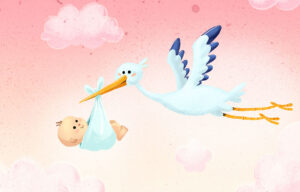
Hello Beautiful
A New Dad Reports: The Things No One Tells You About Having a Baby (During a Pandemic)

The Story of Greatland
The personal discovery that led to a storytelling collective, designed to empower fearless creators

The Week Before
Having a baby can be stressful. Toss in a global pandemic and it’s downright maddening.

Dear Old Dad
Few things are stranger than a new parent’s brain. How becoming a new Dad made me rethink life and death.

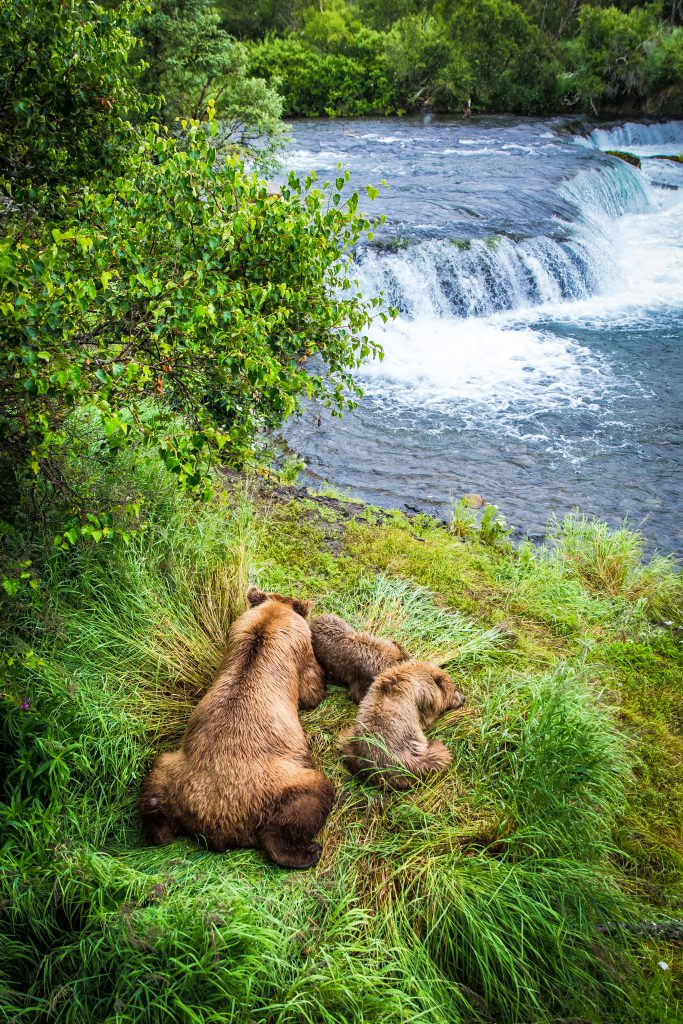
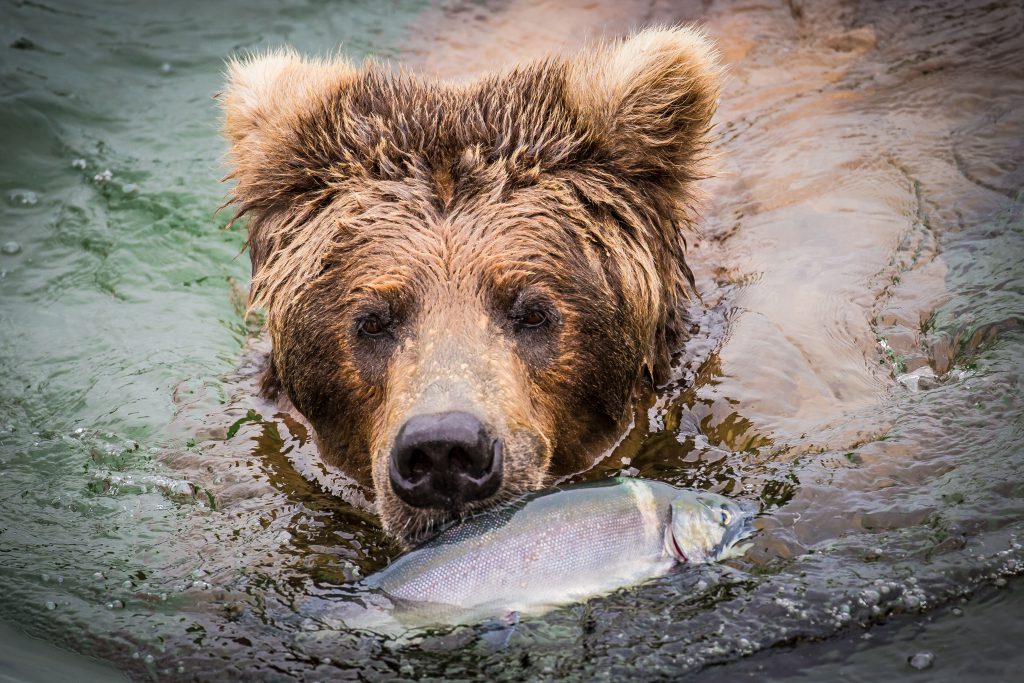


194 Responses
Comments are closed.